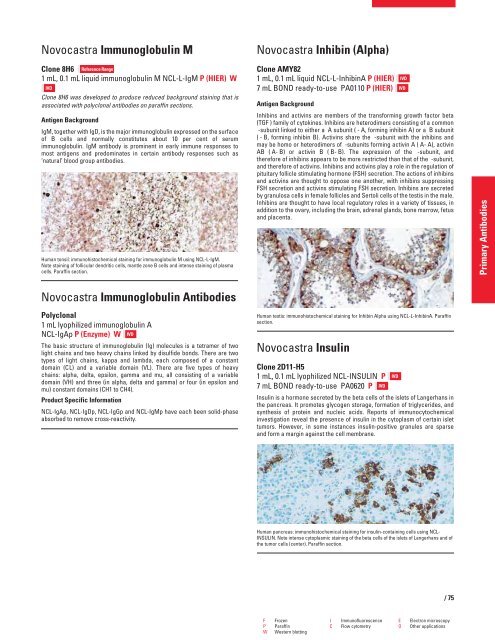QF0159 Marketing Release Record
QF0159 Marketing Release Record
QF0159 Marketing Release Record
You also want an ePaper? Increase the reach of your titles
YUMPU automatically turns print PDFs into web optimized ePapers that Google loves.
Novocastra Immunoglobulin M<br />
Clone 8H6 Reference Range<br />
1 mL, 0.1 mL liquid immunoglobulin M NCL-L-IgM P (HIER) W<br />
IVD<br />
Clone 8H6 was developed to produce reduced background staining that is<br />
associated with polyclonal antibodies on paraffin sections.<br />
Antigen Background<br />
IgM, together with IgD, is the major immunoglobulin expressed on the surface<br />
of B cells and normally constitutes about 10 per cent of serum<br />
immunoglobulin. IgM antibody is prominent in early immune responses to<br />
most antigens and predominates in certain antibody responses such as<br />
‘natural’ blood group antibodies.<br />
Human tonsil: immunohistochemical staining for immunoglobulin M using NCL-L-IgM.<br />
Note staining of follicular dendritic cells, mantle zone B cells and intense staining of plasma<br />
cells. Paraffin section.<br />
Novocastra Immunoglobulin Antibodies<br />
Polyclonal<br />
1 mL lyophilized immunoglobulin A<br />
NCL-IgAp P (Enzyme) W IVD<br />
The basic structure of immunoglobulin (Ig) molecules is a tetramer of two<br />
light chains and two heavy chains linked by disulfide bonds. There are two<br />
types of light chains, kappa and lambda, each composed of a constant<br />
domain (CL) and a variable domain (VL). There are five types of heavy<br />
chains: alpha, delta, epsilon, gamma and mu, all consisting of a variable<br />
domain (VH) and three (in alpha, delta and gamma) or four (in epsilon and<br />
mu) constant domains (CH1 to CH4).<br />
Product Specific Information<br />
NCL-IgAp, NCL-IgDp, NCL-IgGp and NCL-IgMp have each been solid-phase<br />
absorbed to remove cross-reactivity.<br />
Novocastra Inhibin (Alpha)<br />
Clone AMY82<br />
1 mL, 0.1 mL liquid NCL-L-InhibinA P (HIER)<br />
7 mL BOND ready-to-use PA0110 P (HIER)<br />
Antigen Background<br />
Inhibins and activins are members of the transforming growth factor beta<br />
(TGF ) family of cytokines. Inhibins are heterodimers consisting of a common<br />
-subunit linked to either a A subunit ( - A, forming inhibin A) or a B subunit<br />
( - B, forming inhibin B). Activins share the -subunit with the inhibins and<br />
may be homo or heterodimers of -subunits forming activin A ( A- A), activin<br />
AB ( A- B) or activin B ( B- B). The expression of the -subunit, and<br />
therefore of inhibins appears to be more restricted than that of the -subunit,<br />
and therefore of activins. Inhibins and activins play a role in the regulation of<br />
pituitary follicle stimulating hormone (FSH) secretion. The actions of inhibins<br />
and activins are thought to oppose one another, with inhibins suppressing<br />
FSH secretion and activins stimulating FSH secretion. Inhibins are secreted<br />
by granulosa cells in female follicles and Sertoli cells of the testis in the male.<br />
Inhibins are thought to have local regulatory roles in a variety of tissues, in<br />
addition to the ovary, including the brain, adrenal glands, bone marrow, fetus<br />
and placenta.<br />
Human testis: immunohistochemical staining for Inhibin Alpha using NCL-L-InhibinA. Paraffin<br />
section.<br />
Novocastra Insulin<br />
Clone 2D11-H5<br />
1 mL, 0.1 mL lyophilized NCL-INSULIN P<br />
7 mL BOND ready-to-use PA0620 P IVD<br />
Insulin is a hormone secreted by the beta cells of the islets of Langerhans in<br />
the pancreas. It promotes glycogen storage, formation of triglycerides, and<br />
synthesis of protein and nucleic acids. Reports of immunocytochemical<br />
investigation reveal the presence of insulin in the cytoplasm of certain islet<br />
tumors. However, in some instances insulin-positive granules are sparse<br />
and form a margin against the cell membrane.<br />
Human pancreas: immunohistochemical staining for insulin-containing cells using NCL-<br />
INSULIN. Note intense cytoplasmic staining of the beta cells of the islets of Langerhans and of<br />
the tumor cells (center). Paraffin section.<br />
F Frozen I Immunofluorescence E Electron microscopy<br />
P Paraffin C Flow cytometry O Other applications<br />
W Western blotting<br />
IVD<br />
IVD<br />
IVD<br />
/75<br />
Primary Antibodies
















